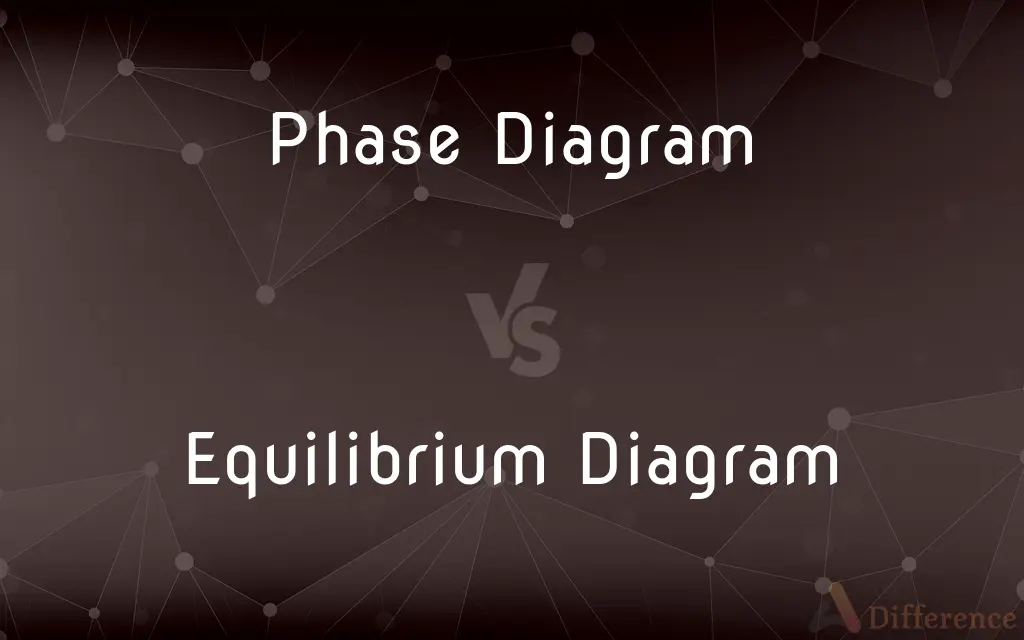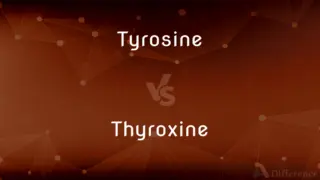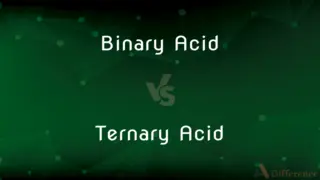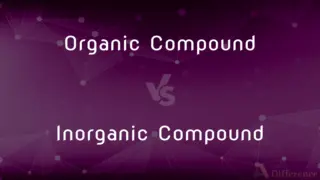Phase Diagram vs. Equilibrium Diagram — What's the Difference?
By Tayyaba Rehman — Published on January 8, 2024
A Phase Diagram shows different states of matter under varying conditions, while an Equilibrium Diagram represents the stability of phases at equilibrium.

Difference Between Phase Diagram and Equilibrium Diagram
Table of Contents
ADVERTISEMENT
Key Differences
Phase Diagrams are graphical representations that show the states of matter (solid, liquid, gas) of a substance at different temperatures and pressures. These diagrams are crucial in materials science and chemistry for understanding how a substance behaves under various conditions. Equilibrium Diagrams, often used interchangeably with phase diagrams in some contexts, specifically focus on the equilibrium conditions of different phases and are particularly important in studying chemical reactions and systems where multiple phases coexist at equilibrium.
In a Phase Diagram, the axes typically represent temperature and pressure, and the diagram shows areas corresponding to different phases (like solid, liquid, and gas), as well as lines representing phase transitions (like melting or boiling points). Equilibrium Diagrams are more commonly used in the context of chemical equilibrium, such as in the study of reactions, where the axes might represent concentrations of reactants and products, or other variables affecting the reaction's equilibrium state.
Phase Diagrams are widely used in physics and engineering to predict the phase changes that a material might undergo in different environmental conditions. This is crucial for applications like materials manufacturing and design. In contrast, Equilibrium Diagrams are essential in chemistry and chemical engineering for understanding and predicting the outcomes of chemical reactions under various conditions.
The key distinction lies in their application: Phase Diagrams are more about physical states and transitions, while Equilibrium Diagrams are about chemical compositions and reactions at equilibrium. For instance, a phase diagram of water would show its solid, liquid, and gas states, whereas an equilibrium diagram might detail the concentrations of reactants and products in a chemical reaction over time.
Both types of diagrams are tools for understanding how substances behave under different conditions, but while Phase Diagrams are more about physical changes, Equilibrium Diagrams delve into the chemical changes and stability of substances in a reaction.
ADVERTISEMENT
Comparison Chart
Primary Focus
States of matter under various conditions
Stability of phases at equilibrium
Typical Axes
Temperature and Pressure
Concentrations, reaction conditions
Application Field
Materials science, physics, engineering
Chemistry, chemical engineering
Represented Transitions
Physical state changes (e.g., melting)
Chemical reactions and stability
Usage Example
Predicting material behavior in environments
Predicting reaction outcomes and compositions
Compare with Definitions
Phase Diagram
Visual representation of phase stability in different conditions.
The phase diagram of helium helps in understanding its liquid state properties at low temperatures.
Equilibrium Diagram
Focuses on chemical equilibrium in reactions.
The Le Chatelier’s principle can be visualized using an equilibrium diagram.
Phase Diagram
Shows different states of matter at various temperatures and pressures.
The water phase diagram illustrates its solid, liquid, and gas states.
Equilibrium Diagram
Illustrates concentrations and reaction conditions.
The equilibrium diagram for ammonia synthesis shows optimal conditions for production.
Phase Diagram
Used to understand material behavior under environmental changes.
Engineers use the iron-carbon phase diagram for steel manufacturing.
Equilibrium Diagram
Used in chemistry for predicting reaction outcomes.
Equilibrium diagrams help in understanding acid-base titrations.
Phase Diagram
Crucial in materials science for predicting substance properties.
The silicon phase diagram is essential in semiconductor fabrication.
Equilibrium Diagram
Represents the stability of phases at equilibrium conditions.
The equilibrium diagram of a chemical reaction shows reactant and product concentrations over time.
Phase Diagram
Indicates phase transitions like melting and boiling points.
The CO2 phase diagram shows sublimation at atmospheric pressure.
Equilibrium Diagram
Essential in chemical engineering for process design.
Equilibrium diagrams guide the design of chemical reactors.
Common Curiosities
What is a phase diagram?
A graphical representation showing various states of matter of a substance under different conditions.
What is an equilibrium diagram?
A chart that illustrates the stability and proportions of phases in a chemical system at equilibrium.
What kind of information does an equilibrium diagram provide?
It provides information on the concentrations of reactants and products in a reaction at equilibrium.
What’s the difference between a phase diagram and a state diagram?
A phase diagram focuses on matter's states under physical conditions, while a state diagram in other contexts might refer to system states in processes or computation.
How are phase diagrams used in engineering?
They help predict how materials behave in different environmental conditions.
Why are equilibrium diagrams important in chemistry?
They provide insights into the balance and outcomes of chemical reactions.
Are phase diagrams applicable to mixtures?
Yes, phase diagrams can also be created for mixtures and alloys.
What does a phase diagram typically show?
It shows the conditions at which a substance exists in solid, liquid, and gas states.
Are phase and equilibrium diagrams used together?
They can be used complementarily, especially in fields like material science and chemical engineering.
Can phase diagrams be used for all substances?
Yes, every substance can have its own phase diagram.
Can phase diagrams predict the exact point of phase change?
They provide approximate conditions under which phase changes occur.
Can equilibrium diagrams be used for all chemical reactions?
They are useful for reactions where equilibrium is established, but not all reactions reach equilibrium.
Do equilibrium diagrams only apply to chemical reactions?
Mostly, but they can also apply to physical processes where equilibrium is a factor.
How are equilibrium diagrams used in industrial processes?
They are used to design and optimize chemical processes and reactors.
What role do phase diagrams play in materials science?
They are crucial for understanding and predicting the behavior of materials under various conditions.
Share Your Discovery

Previous Comparison
Effortlessly vs. Seamlessly
Next Comparison
2 Pole Motors vs. 4 Pole MotorsAuthor Spotlight
Written by
Tayyaba RehmanTayyaba Rehman is a distinguished writer, currently serving as a primary contributor to askdifference.com. As a researcher in semantics and etymology, Tayyaba's passion for the complexity of languages and their distinctions has found a perfect home on the platform. Tayyaba delves into the intricacies of language, distinguishing between commonly confused words and phrases, thereby providing clarity for readers worldwide.
















































